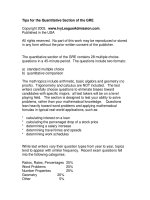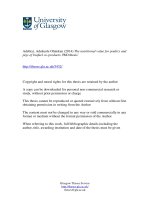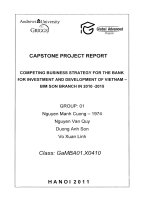QUIZ FOR THREE MAIN ISSUES OF ECONOMY
Bạn đang xem bản rút gọn của tài liệu. Xem và tải ngay bản đầy đủ của tài liệu tại đây (35.58 KB, 4 trang )
QUIZZ FOR THREE MAIN ECONOMIC ISSUES
1. What are the limitations of a Free enterprise system?
A.High taxation and less incentive to work hard
B.Uneven distribution of resources, consumer difficulty in obtaining information, and
health-risk products
C.Restrictions on personal freedoms
D.There are no limitations
2. What are the limitations of a Mixed economy?
A.High taxation and less incentive to work hard
B.All profit goes to the government
C.Restrictions on personal freedoms
D.Uneven distribution of resources, consumer difficulty in obtaining information, and
health-risk products
3. The term that indicates ownership, either by individuals or by a business, is ...
A.Centrally planned economy
B.Competition
C.Free enterprise
D.Private property
4. An economic system in which business are allowed to produce any goods and
services they wish to is referred to as ...
A.A centrally planned economy
B.Free enterprise
C.A mixed economy
D.A private economy
5. A situation that occurs when two or more businesses try to sell the same type of
product to the same customers is referred to as ...
A.Competition
B.Factors of production
C.Consumer goods
D.Free enterprise
6. The items that consumers buy are called ...
A.Private property
B.Factors of production
C.Producer goods
D.Consumer goods
7. Things that are needed to produce goods and services are called ...
A.Efficient use of resources
B.Factors of production
C.Economic systems
D.Private property
8. An economic system in which private property is almost totally restricted is
called ...
A.A mixed economy
B.Competition
C.Free enterprise
D.A centrally planned economy
9. An economic system that has Government restrictions on the actions of individuals
and businesses is called ...
A.A mixed economy
B.Factors of production
C.A centrally planned economy
D.Free enterprise
10. Goods that are used to produce other goods are called ...
A. Consumer goods
B. Private property
C. Producer goods
D. Competition
11.Three basic types of economic systems are ...
A. Natural resources, labour, capital
B. What to produce, how to produce, who will receive the goods and services
C. Free enterprise, centrally planned economy, mixed economy
D. Government, business, consumers
12. The basic ideas that make a free enterprise system work are ...
A. Competition, profit, and private property
B. Freedom, efficient use of resources, and profit
C. Profit, efficient use of resources, and risk
D. Natural resources, profit, and private property
13. When referring to a free enterprise system, "private property" means that ...
A. No one is allowed access to a particular place
B. Equipment and buildings can be owned by individuals or businesses
C. One must ask permission before entering someone's yard
D. Things and buildings can be owned by individuals and governments
14. The words "producer goods" describe ...
A. The final product that a producer makes
B. The products made by all producers
C. The goods used to produce other goods
D. Equipment but not factories and offices
15. The phrase "profit is the incentive for business" means that profit ...
A. Provides a strong reason to reduce investment
B. Reduces the need for efficient use of resources
C. Provides a reward for the risk and effort involved
D. Provides the incentive to increase expenses
16. Competition occurs if ...
A. Two or more businesses try to sell the same type of goods or services to the same
customer
B. Government agencies are the only producers of goods or services
C. One business has the approval to sell the total production of one type of good or
service
D. One large business owns all the natural resources needed to produce some
particular product
17. Canada's economy is referred to as a mixed economy because ...
A. Producers can produce whatever they wish
B. Businesses can act independently without government interference
C. Government is involved in regulating and owning some businesses
D. Government owns all businesses
18. A centrally planned economy promotes ...
A. Private property, profit, and competition
B. Government ownership, no competition, and no profit
C. Government ownership, competition, and no profit
D. Government ownership, profit, and no competition
19. A centerally planned economy has ...
A. A large planning agency, many government employees, and many social benefits
B. A large planning agency, many personal freedoms, and many social benefits
C. Large military spending, incentive to work to benefit individuals, and a large
bureaucracy
D. Large military spending, a large bureaucracy, and many personal freedoms
20. What is the basic question(s) all economic systems try to answer?
A. What to produce?
B. How to produce it?
C. For whom to produce?
D. All of the above.
21. What is an economic problem every nation has?
A. The problem of meeting every one's needs.
B. Not enough population.
C. Too much pollution.
D. Not enough resources.
22. When deciding "what to produce", what is said to be limited?
A. Population
B. Power
C. Resources
D. Water
23. Who makes the decisions in a Free Enterprise economy?
A. The consumer and businesses
B. The government
C. Pets
D. Voters
24. In a Free Enterprise economy, private property is...
A. Discouraged
B. Limited
C. Encouraged
D. Non-existent
25. What is the main goal of a Mixed Economy?
A. To gain private property
B. To ensure fairness in business
C. To get rid of high taxation
D. To promote individual and social rights









